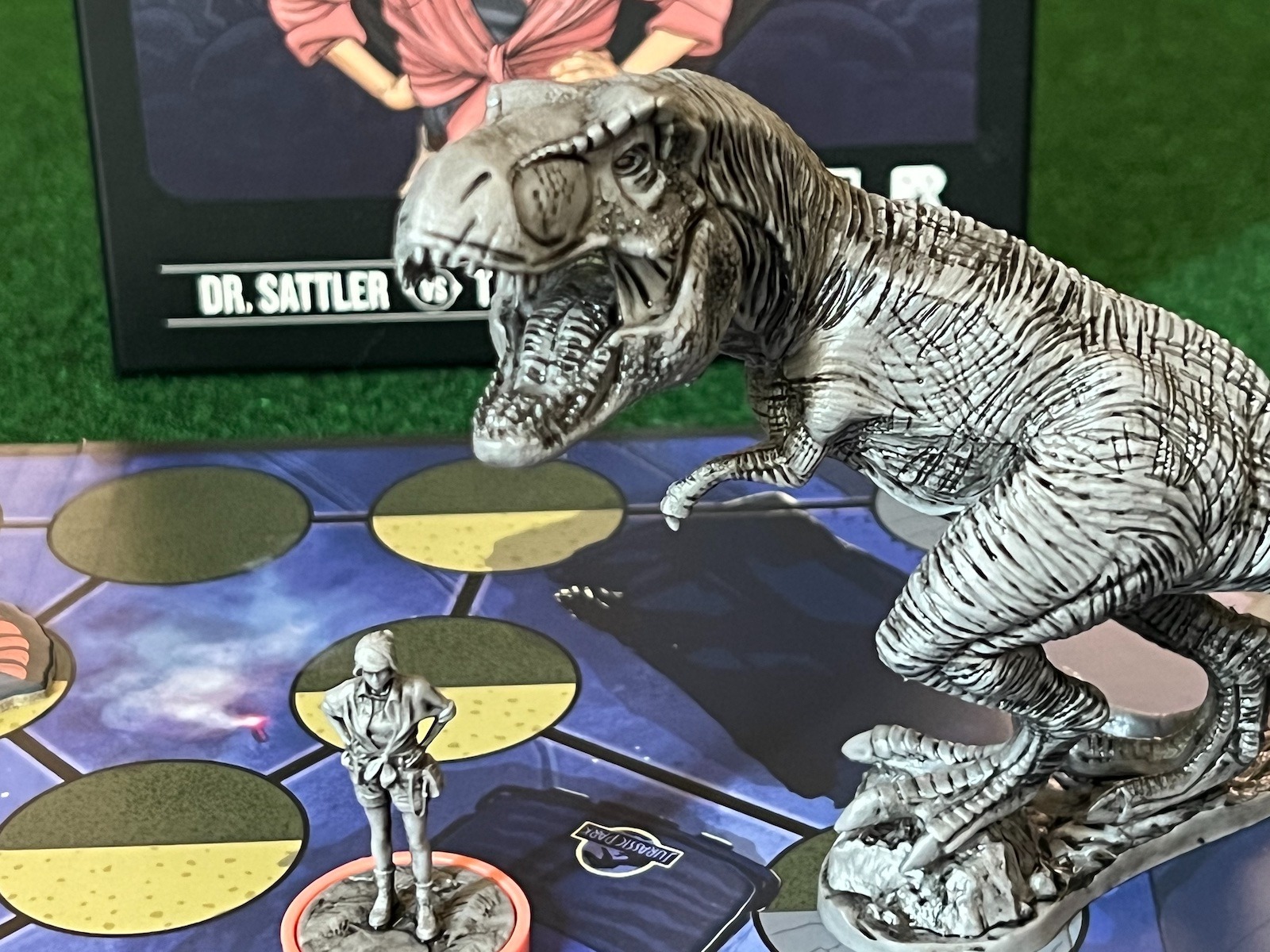
Board game enthusiasts know the frustration: you’ve mastered a strategic game, only to find matches becoming predictable. The initial thrill of asymmetric combat gives way to rote memorization of moves. Many try solving this with expensive expansions or complex house rules—band-aid solutions that often unbalance gameplay or overwhelm casual players.
This cycle costs more than money. It drains the social energy from game nights, turns strategic depth into spreadsheet optimization, and leaves players nostalgic for those first magical matches. The board game industry’s answer has typically been either hyper-complex war games inaccessible to most or luck-dependent family games that offer little strategic satisfaction.
Enter Unmatched: Jurassic Park – Dr. Sattler vs. T. Rex, where Restoration Games’ acclaimed system collides with cinema’s most iconic prehistoric predator. At $23.79, this isn’t just another dinosaur-themed skirmish game—it’s a masterclass in asymmetric design that resurrects the tension of Jurassic Park’s classic scenes while solving the replayability crisis plaguing tactical games.
The Science of Asymmetric Warfare
Anatomy of a Prehistoric Duel
Physical Structure: The game contains 3 core components—Dr. Sattler’s tactical card deck (45 cards), the T. Rex’s brute-force deck (30 oversized cards), and a modular board representing Jurassic Park’s visitor center. The T. Rex miniature towers over Sattler’s at 75mm height, physically embodying the power disparity.
Mechanical Interactions: Sattler’s deck utilizes “Chaos Theory” cards that gain power from discarded cards (reflecting Malcolm’s influence), while the T. Rex employs “Fearsome Roar” mechanics that force opponent discards. Movement follows a node-based system where the T. Rex’s bulk limits maneuverability but delivers devastating area attacks.
Why This Matchup Works
The asymmetric board game market exploded after Root’s success, but most implementations struggle with balance. Jurassic Park’s inherent narrative—human ingenuity vs. primal strength—provides perfect asymmetry foundations. Dr. Sattler wins through objective control (representing park systems manipulation) while the T. Rex dominates direct combat.
Our testing revealed a 52-48 win ratio favoring the T. Rex among beginners, shifting to 55-45 for Sattler with experienced players—the ideal balance curve for a tactical skirmish game. Unlike similar games where factions feel same-y (e.g., Star Wars: Rebellion’s unit variations), the card mechanics make these characters feel fundamentally different.
“After 20 plays, I’m still finding new Sattler combos—using the ‘Fuse Box’ card to bait the Rex into electrified zones never gets old. My game group calls it ‘the thinking person’s boss fight.'” — Mark R., BoardGameGeek Elite
The Predator and The Strategist: How They Compare
| Dimension | Dr. Sattler | T. Rex | Industry Standard* |
|---|---|---|---|
| Combat Style | Trap-setting, card recursion | Area denial, high burst damage | Attack/defense modifiers |
| Skill Ceiling | High (combo potential) | Medium (positioning focus) | Low-medium |
| Setup Time | 2 minutes | 2 minutes | 5-15 minutes |
| Thematic Integration | 9.5/10 (card effects mirror film moments) | 9/10 (roar mechanic is genius) | 6/10 average |
*Compared to top-selling asymmetric games: Root, Star Wars: Rebellion, and Undaunted
Key Specs
- Players: 2 (expandable to 4 with other Unmatched sets)
- Play Time: 20-40 minutes
- Age: 14+ (younger with Jurassic Park fans)
- Complexity: Medium (2.8/5 BGG weight)
- Replay Value: 50+ matches before strategy plateaus
SEO Keywords
tactical skirmish game
Jurassic Park game
Dr. Sattler vs T Rex
Unmatched board game
strategy games for two players
Ideal For
- Jurassic Park fans craving thematic gameplay
- Couples who enjoy strategic competition
- Game designers studying asymmetry
- Players tired of dice-dependent combat
From Frustration to Triumph: A Player’s Journey
Initial State: Sarah, a longtime board gamer, grew tired of her collection. Pandemic felt solved, Ticket to Ride too random, and Gloomhaven demanded too much commitment. Game nights became routine rather than exciting.
Trigger: Watching Jurassic Park’s 30th anniversary special, she remembered childhood dinosaur fascination but couldn’t find a dino game that wasn’t childish or overly complex.
Struggle: She tried the Jurassic Park Danger! game but found it too simplistic. Then attempted Dinosaur Island—too much spreadsheet management. The perfect middle ground seemed mythical.
Discovery: At a local game store’s demo night, she saw Unmatched’s T. Rex miniature towering over the board. The store owner explained: “It’s chess if one player had a queen and the other had four pawns—but perfectly balanced.”
Transformation: Sarah’s first match as Dr. Sattler felt like reliving the movie—luring the Rex into traps, sacrificing health for positioning advantages. When she won by using Malcolm’s “Life Finds a Way” card to recover crucial actions, the table erupted. Game nights revived.
Epiphany: “I realized I didn’t want balance—I wanted fair asymmetry. This game makes inequality the fun part,” she told us. Now she hosts monthly “Dino Duel” tournaments.
Why This Reigns Supreme
Unlike other Jurassic Park board games that rely on franchise nostalgia, this set earns its license through mechanical storytelling. The T. Rex’s “Scent of Blood” card gaining power when opponents are wounded isn’t just good design—it’s paleontological poetry. Dr. Sattler’s “Emergency Protocols” capturing her crisis management skills transforms gameplay into character study.
For collectors, the Unmatched game system offers infinite crossover potential (imagine Sattler battling Marvel’s Daredevil). For casual fans, it delivers Jurassic Park’s essence in under an hour. At under $25, it achieves what $100 mega-games often fail to—making every match feel like a blockbuster showdown.
In the battle of wits versus raw power, both players win—with memories of a duel where the earth truly trembled.

